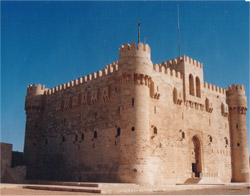The Citadel of Qaitbay stands as a striking symbol of Alexandria’s historical resilience and architectural brilliance. Nestled at the entrance of the eastern harbor on the eastern edge of Pharos Island, the Citadel occupies the exact site where the ancient and legendary Lighthouse of Alexandria once stood—one of the Seven Wonders of the Ancient World. Today, it serves not only as a military relic but as a powerful testament to centuries of Egyptian strength, strategy, and survival.
The story of the Citadel begins in 1477 A.D. (882 Hijri), when Sultan Al Ashraf Abou Anasr Saif El Din Qaitbay, a prominent Mamluke ruler, visited the ruins of the old lighthouse. Disturbed by its dilapidated state yet mindful of its strategic location, he ordered the construction of a formidable fortress on the same foundations. Over the next two years, the fortress took shape—at a tremendous cost of more than 100,000 gold dinars.
Qaitbay was no ordinary ruler. Born around 1423 A.D., he arrived in Egypt as a young Mamluke. Through dedication and military skill, he rose through the ranks to become the Chief of the Army before finally ascending the throne in 1468. His rule, which lasted 29 years, marked one of the most stable and influential periods of the Mamluke era. The Citadel was part of his broader vision to fortify Egypt’s coast against the growing threat of the Ottoman Turks.
Built for military defense, the Citadel was designed with thick walls, towers, and strategically placed openings for archers, cannons, and catapults. It features three major architectural elements: the outer walls that enclose nearly two acres, the inner walls, and the main tower. The tower was constructed directly on the remains of the Lighthouse of Alexandria, blending history with defense. Red granite columns from the ancient lighthouse were repurposed in the structure, particularly in the northwest section.
The fortress gained continued importance through subsequent reigns. Sultan Qansoh El Ghoury, another Mamluke ruler, paid special attention to it by increasing the size of the garrison and stocking it with weapons. He also issued a strict decree prohibiting the removal of any arms or soldiers from the Citadel—an edict so serious that it was inscribed on a marble slab by the entrance, declaring death to anyone who dared violate it.
When the Ottomans conquered Egypt, they preserved the Citadel, using it as a coastal stronghold much like they did with the Citadel of Saladin in Cairo. They stationed infantry, artillery, musicians, and craftsmen there, keeping it operational and intact. The fortress’s strategic location made it indispensable for any power controlling Egypt.
During the rule of Mohammed Ali, who came to power in 1805, the Citadel underwent substantial restoration. He reinforced its ramparts and equipped it with the most advanced weaponry of the era, including coastal cannons. Under his leadership, the Citadel experienced a revival, serving as both a defensive outpost and a symbol of modernization.
However, its fortunes changed dramatically in 1882 during the Orabi Revolt, when the British Navy bombarded Alexandria. On July 11th of that year, the fortress sustained heavy damage, particularly on its northern and western facades. The western wall was severely cracked, and parts of it collapsed entirely under relentless cannon fire. After the assault, the Citadel faded from military use and became neglected for decades.
It wasn’t until the 20th century that the Citadel of Qaitbay received the attention it deserved. The Egyptian Supreme Council of Antiquities began several restoration projects, aiming to return the structure to its former glory. Today, it is one of Alexandria’s most visited historical landmarks, drawing visitors from around the world who come to admire its design, history, and the stunning views of the Mediterranean it provides.
The fortress is built primarily from limestone, with decorative elements and archways constructed from granite. The wooden door currently standing at the main entrance dates back to the English occupation of Egypt, though the original architectural design remains visible throughout. Above the entrance, an ominous spillway once allowed defenders to pour hot oil on invaders—a chilling reminder of the fortress’s wartime function.
The Citadel of Qaitbay is more than a coastal stronghold. It is a convergence point of history, representing the Mamlukes’ ingenuity, the Ottomans’ pragmatism, and Egypt’s enduring strength through centuries of change. From the ruins of the ancient lighthouse rose a beacon of military might that has, for over 500 years, guarded the Mediterranean gateway to Egypt.

🧩 Facts at a Glance
| Feature | Details |
|---|---|
| Location | Eastern point, Pharos Island, at entrance to Eastern Harbour |
| Construction | 1477–79 by Sultan Qaitbay; revived 1805 by Muhammad Ali; major restoration 1984 |
| Materials | Limestone, granite (lighthouse remnants), Aswan red-granite features |
| Dimensions | Outer walls: ~8–15 m high, ~3 m thick; footprint: 60 × 50 m (~17,550 m²); tower ~17 m tall |
| Floors | Mosque on ground, storage on second, observation and service rooms on top |
| Defenses | Towers, battlements, cannon ports, arrow slits, hot-oil holes, portcullis |
| Military use | Mamluk, Ottoman, French, Egyptian, British control over centuries |
| Current use | Maritime Museum, cultural site, tourist attraction |
🧭 Why Visit the Citadel of Qaitbay?
- 🏰 Marvel at a Mamluk fortress built on the site of a Wonder of the World
- ⚓ Explore centuries of coastal defense and Mediterranean power struggles
- 📸 Enjoy panoramic Mediterranean views atop ramparts
- 🎟️ Visit the museum’s naval exhibits and artifacts spanning eras
- 🏞️ Stroll the historic Corniche with its coastal museums, cafés, and street life
